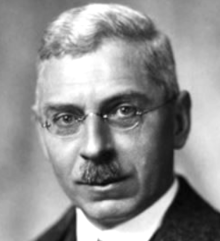
Basil Oliver was born at The Brewery House, Cornard Road, Sudbury, Suffolk, England on 12 May 1882. He studied at Liverpool University School of Architecture from 1900 to 1902 when he moved to London. From 1902 to 1904 he was articled to Edward Prioleau Warren (1856-1937). He also attended the Architectural Association Schools, Royal Academy Schools, and the L.C.C. Central School of Arts and Crafts in London. After completing his articles he worked as an assistant to Holloway Brothers, builders in 1904-05; and to Arthur William Blomfield (1829-1899), Charles James Blomfield (1862-1932) and Arthur Conran Blomfield (1863-1935) of Arthur Blomfield & Sons in 1905-06. In 1906 he returned to the office of E. P. Warren where he was employed as an assistant until 1909.
Oliver qualified as an architect in 1910 and was elected an Associate of the Royal Institute of British Architects (ARIBA) later that year. He subsequently returned to the Brewery House in Sudbury where he commenced practice as an architect. He also taught Architecture and Building at Central School. of Arts and Crafts.
Among Oliver's architectural commissions were the Dunmow War Memorial (1921); the 'Rose & Crown' public house in Cambridge (1928); the Borough Offices in Bury St Edmund's, Suffolk (1935-37); inns for the brewers Greene King; and various houses in East Anglia.
Oliver had a particular interest in vernacular architecture and was the author of 'Old Houses and Village Buildings in East Anglia' (1912) and 'The Cottages of England: A Review of the Types and Features from the 16th to the 18th Centuries' (1929). He also wrote 'The Renaissance of the English Public House' (1947).
Oliver was elected a Fellow of the Royal Institute of British Architects (FRIBA) in 1920. He became a member of the Art Workers Guild in 1913 and was Master of the Guild in 1932. He was also a Fellow of the Society of Antiquaries, a member of the Society for the Protection of Ancient Buildings, and from 1890 to 1936 was a member of the Ipswich Art Club. Architectural paintings by Oliver were shown on seven occasions at the Summer Exhibitions of the Royal Academy in London between 1910 and 1929. He also participated in the 9th exhibition of the Arts & Crafts Exhibition Society in London in 1910 at which he exhibited a design for a house in Sudbury, Suffolk.
His address was given as 31 Hugh Street, Eccleston Square, London [office] in 1910; The Brewry House, Cornard Road, Sudbury, Suffolk [home] in 1911; 7 Southampton Street, Bloomsbury, London [office] in 1910 and 1920; The Limes Great Cornard, Sudbury, Suffolk i[home] n 1921;148 Kensington High Street, London [office] in 1921 and 1929; 6 Tennyson Mansions, Fulham, London [home] in 1939; and 6 Unwin Mansions, Queens Club Gardens, London [home] in 1941 and 1948. He died in Sudbury on 5 May 1948.
Beach School, Lowestoft (in conjunction with Henry J. Chetwood, F.R.I.B.A.), 1912-13: memorials at Blythburgh Church, Suffolk (1912), Hadley, Barnet (1913), at the General Hospital, Tunbridge Wells (1914), and at the General Infirmary, Leeds (1914). War memorials at Dunmow, in the Cathedral Church and School at Bury St. Edmunds, in Assington Church (Suffolk), at Corpus Christi College (Cambridge), Mission Church, Hatcham, S.E.15, etc.; house at Pyrford, Surrey, 1913-14; "The Stone and Faggot" Inn, Little Yeldham, Essex, 1915; alterations and additions to " Rosmeade", Ulting, Maldon, Essex, 1920; Imber Court, House (rebuilding), 1921: restorations of: — Ballingdon Hall, Sudbury, Suffolk, 1921-22, and Isfield Place, near Uckfield, Sussex, 1922. In conjunction with Alan O. Brace: — alterations and additions to Tyrroll's Hall Working Men's Club at Little Thurrock, Essex, 1922; houses at Farnham Common, Bucks (1923), Guildford (1924), Ide Hill, Kent (1924), and near Honiton, Devon (1925); etc. [Source: Who's Who in Architecture 1926]
Directory of British Architects 1834-1914. Compiled by Antonia Brodie, et al. Volume 2: L-Z. London; New York: British Architectural Library, Royal Institute of British Architects/Continuum, 2001
‘Obituary’. The Builder vol. 178, 14 Mqy 1948 p. 585
‘Obituary’. RIBA Journal vol. 55, June 1948 p.373
Oliver, Stephen. ‘Basil Oliver and the End of the Arts and Crafts Movement’. Architectural History vol.47, 2004 pp.329-360
Who's Who in Architecture 1926. Edited by Frederick Chatterton. London: The Architectural Press, 1926